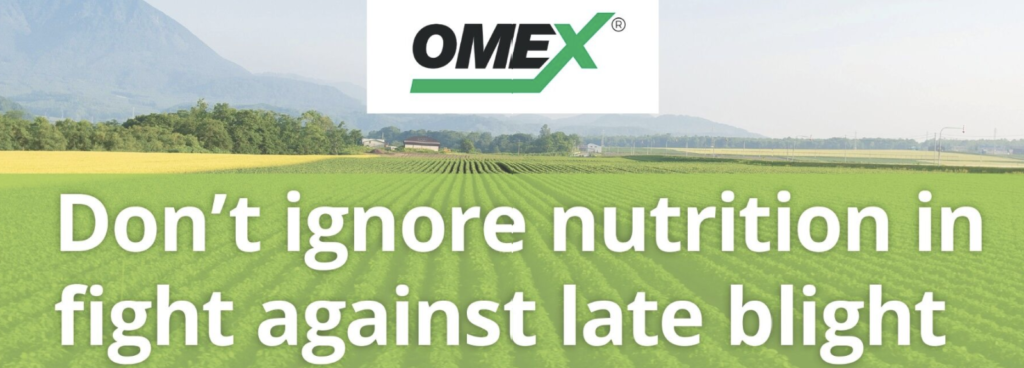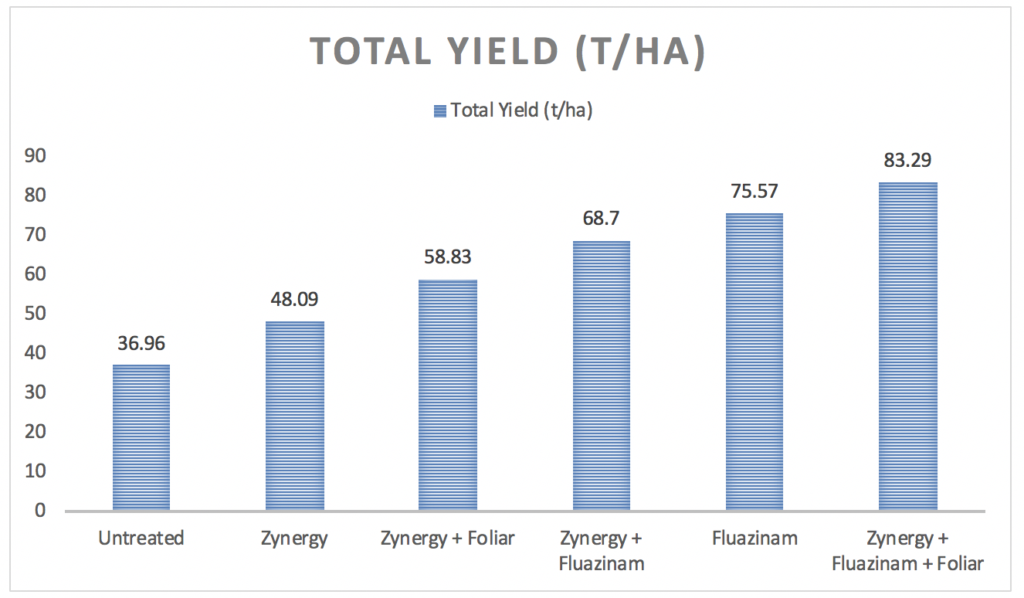Don’t ignore nutrition in fight against late blight
{Sponsored} Access to adequate levels of trace elements can not only enhance the effect of fungicidal treatments in potato crops but lift yield too, according to research from the United Kingdom.
A series of replicated trials carried out by the University of Nottingham and consultancy Eurofins observed how availability of the micronutrients copper and zinc can improve the crop’s ability to withstand disease attacks, such as the late blight caused by the Phytopthora pathogen.
Not only did this relieve the pressure on the fungicide – resistance in blight strains has been a growing concern in recent years, in the U.K. as well as in the United States – it also resulted in a measurable yield increase.
“This is one of those occasions where research confirms a common-sense, gut feeling,” says OMEX® agronomist Dean Konieczka. “Just like us, if a plant is healthy, well-fed and unstressed, it’s less likely to succumb to pathogenic infection and disease.
“Previous observations, anecdotal evidence and in-house research had all pointed towards promise in this area, so the trial with Nottingham University, arranged by OMEX® in the UK, gave us the opportunity to put some proper science behind it.
“There’s a lot of misinformation about crop nutrition, a lot of pseudo-science. Nutrition isn’t as closely regulated as that of agrochemicals,” he explains, “and that can lead to some dubious claims being made.”
The replicated trials featured Cell Power® Zynergy™, a combination of copper, zinc and organic acids. Formulated to provide enhanced ‘bio-availability’ – a term describing how easily the target plant can absorb and utilize the product – Dean says the product is ideal for use in an integrated crop management (ICM) program as a means of enhancing fungicidal activity. Besides blight, the product is also an effective additive in measures against rust and downy mildew.
Both copper and zinc fulfill vital roles in plant metabolism, but they are especially important in supporting the crop’s immune system. Zinc serves to maintain what’s known as the ‘integumentary’ system. Comprising the epidermis, leaf cuticle and plant hairs, it’s the first line of defense against physical damage and attack from pathogens. High levels of zinc improve elasticity, wound healing and disease suppression.
Copper, meanwhile, is a crucial component in the production of phenolic compounds. This large and diverse group of plant metabolites influences plant growth and defense responses, both to pathogenic infection and physical damage.
“According to the research from Nottingham, Zynergy’s™ formulation seems to enhance the bioavailability of these micronutrients,” explains Dean. “Although we’re not 100 per cent sure about the mode of action, we are certain it has no fungicidal properties itself; the product is a genuine fertilizer and that’s how it’s registered.”
The initial laboratory tests at the University of Nottingham compared Zynergy™ with tank-mixed zinc oxide and copper sulphate, as well as the contact fungicide mancozeb. On a virulent strain of blight introduced to inoculated potato leaves, the formulated product outperformed the standard mix of copper and zinc, while both Zynergy™ and mancozeb held back the infection satisfactorily.
As the trial progressed to replicated field plots, Zynergy™ was mixed with half-rate fluazinam and a foliar feed, to interesting results. “Here, the researchers reported that the canopy looked better than on the fungicide-only plots,” notes Dean. “As one might expect, an improvement in canopy quality also prolongs its life – and with a prolonged canopy, there’s a stronger yield.”
Perhaps the most striking results came from work on the blight-susceptible variety Maris Piper, a popular maincrop variety that accounts for nearly one-fifth of the national crop. Widely grown since its introduction in 1966, its closest U.S. equivalent – in popularity and blight susceptibility – is Russet Burbank.
Here, Zynergy™ was applied in various combinations with a foliar feed and the fungicide fluazinam:
“The results show that Zynergy™ gave an impressive 14.5 per cent increase in marketable yield where it was applied with fluazinam and a foliar feed,” Dean points out. “That’s a return on investment of more than 30:1. Similar results were also seen in a trial where Zynergy was applied with a mandipropamid/cyazofamid program.”
However, Dean’s keen to dissuade growers from cutting back on any fungicide treatments. “Zynergy’s™ not a substitute, but an additive. Fungicides are systemic, so they treat the whole plant, while movement of copper and zinc through the plant doesn’t confer protection to any unsprayed areas within the canopy.
“Similarly, while Zynergy™ offers some curative action, it’s short-lived – you won’t see the typical fungicide kickback.
“Zynergy’s™ best treated as a protectant. You need to get your program in place, and the plant treated, before disease takes hold.
“And while these results are significant and interesting for growers, it’s important to remember that Zynergy™ is just a highly effective foliar fertilizer that has real benefits in an integrated crop management system. We’re not making a plant protection claim.
“For example, although you might be planning a seven-day spray program, you can’t always stick to it – but with Zynergy™ in the program, you’ll buy yourself a bit more protection, a bit more flexibility and, judging by the U.K. trials, up to 60cwt more potatoes from each treated acre.”
Learn more at www.omexusa.com.
The product names and brands referenced here are registered and trademarks of OMEX® Agrifluids, Inc.
© OMEX® Agrifluids, Inc. 2020.









